Star Wars: The Old Republic‘s new 4.0 update changes everything, as does a fresh expansion to one of the most controversial massively multiplayer games in recent memory.
Last year I asked developers working on the game about their plans for the future. What they told me then is a phrase that reps for the game’s publisher and development studio, EA and Bioware, have repeated ad nauseum in the run-up to this year’s big update, SWTOR 4.0, and the new Knights of the Fallen Empire expansion: “a return to BioWare cinematic storytelling.”
I didn’t believe them. At all.
Good news: They actually did it.
As I wrote last year here on Kotaku, what Bioware did with SWTOR‘s previous expansion, Shadow of Revan, gave me no hope for the game’s future. That expansion would not be mistaken for Bioware cinematic storytelling. It was more of the troubled mashup of Bioware RPG and massively multiplayer online game tropes that it had been since SWTOR launched in 2011, with lower production values.
I recently started playing Knights of the Fallen Empire, which officially comes out for all subscribers of the game on October 27. It feels different. For the most part, it feels like what you would expect a successor to their beloved Knights of the Old Republic to be. It was as if the folks at Bioware Austin had a moment in the past year in which they collectively said “fuck it” and decided to just do it. I recently asked producer Bruce Maclean and lead writer Charles Boyd if that’s what they were thinking, too. “We can’t say that, but you can,” Boyd said.
“This is the year of Star Wars,” he continued. “This is a big year for everyone. And that was it. Why assume that our game is gonna go a certain direction, or things are gonna go a certain way for an online game that’s out been out for a few years?”
The subscriber-only Knights of the Fallen Empire expansion (which you keep even if you unsubscribe later) is accompanied by the most significant patch SWTOR has ever received. That free 4.0 update is a drastic quality-of-life overhaul of many of the basic ways the game functions. It essentially takes the philosophy behind Fallen Empire and attempts to apply it to the previous content. It makes everything that came before far less of an ordeal.
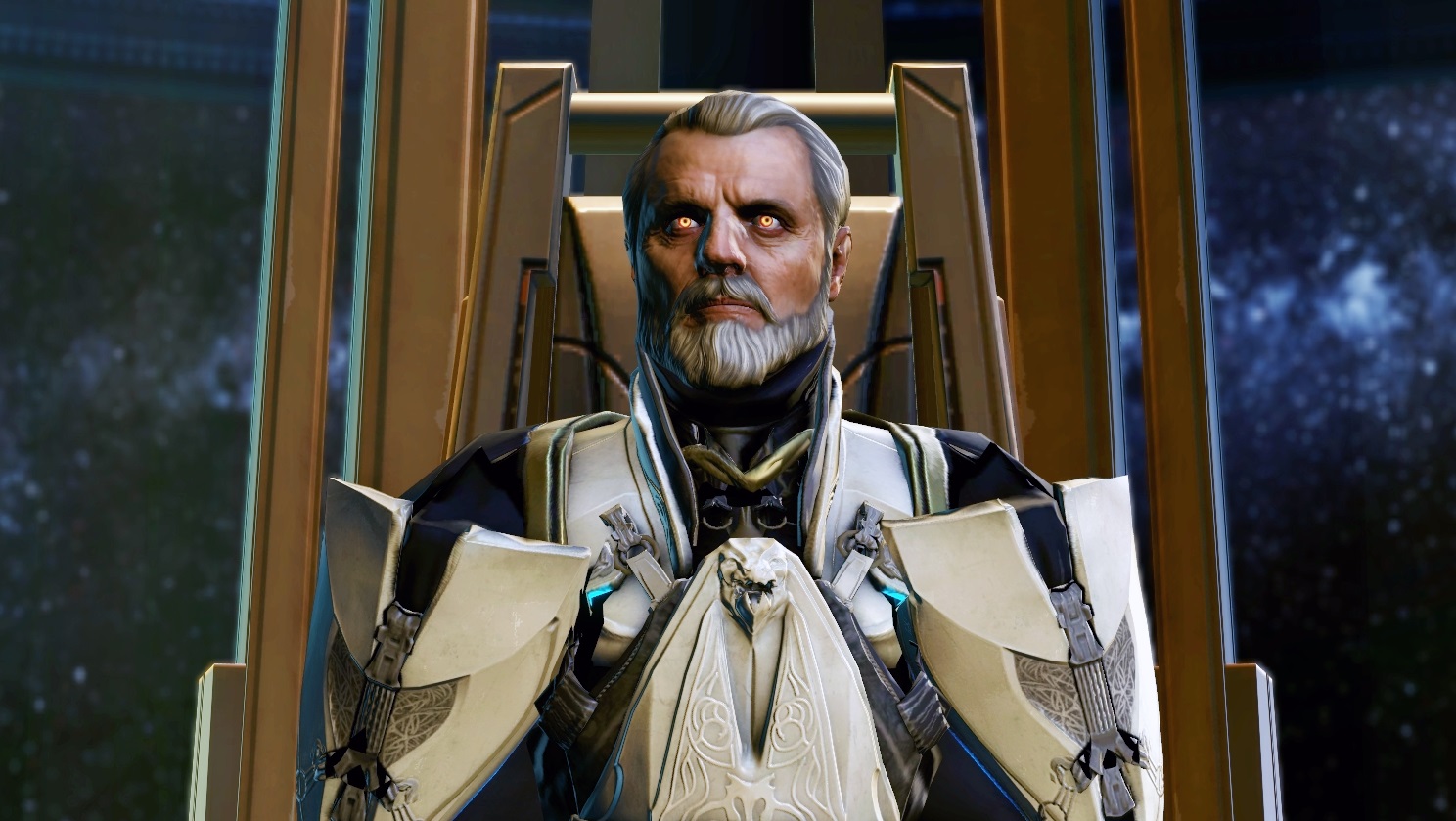
For someone like me who has played SWTOR heavily since it first launched in 2011, the 4.0 update and Knights of the Fallen Empire represents a turning point. It’s a shocking experience, really, and lays bare how the game has gradually become vastly more user-friendly since day one. SWTOR 4.0 is a large step further in that direction, and it’s pretty difficult to comprehend how much has changed since the start. It’s far from perfect, though, and certainly not as good as it could have been had they chosen to build the game this way from the beginning. That they had the gumption to take this path is nice.
The Knights of the Fallen Empire story itself is a massive shift from what we’ve seen before, even just from Shadow of Revan a year ago. Yes, it is another instance of: “third party disrupts the war between the Sith and Republic because there’s now only one main storyline for Sith and Jedi players alike.” This one takes that formula to an unprecedented extreme. Something called the Eternal Empire of Zakuul shows up. This empire boasts a fleet of droid-controlled ships that outstrips any other force in the galaxy and brings both governments to their knees. This new empire has ships patrolling the space lanes but isn’t equipped for a boots-on-the-ground campaign. Your job is to take the empire down by, first, escaping their clutches after being frozen in carbonite for five years and, second, assembling a coalition of the willing to fight back.
Though this all feels pretty out-of-left-field initially, it does continue the greater plot of SWTOR. The old Sith Emperor is still on his endless quest for immortality and omnipotence. He very much has a hand in these events.
Fallen Empire beautifully and almost completely abandons the trappings of MMO questing in favour of more linear dungeon crawling and a heavy emphasis on story scenes. Whereas in vanilla SWTOR, each character class had their own story, the Revan expansion had narrowed that focus to just one shared storyline. With Fallen Empire it feels like we get something in return for that sacrifice with production values in the story scenes that I didn’t think were possible in SWTOR. There aren’t any distracting, irrelevant side quests or extraneous tasks — you just play the story, and the MMOness comes after the core plot is completed. Group dungeons and more mundane activities are compartmentalized outside of the main story thread. The game is going to continue to be this way for a while, at least, as the KotFE story will proceed episodically in 2016. When you play an episode, everything else is put on hold.
And in a nice nod, once the main story is through and you start exploring the MMO-ish activities, you’ll often find yourself in conversations that are a direct homage to KOTOR. Like this:
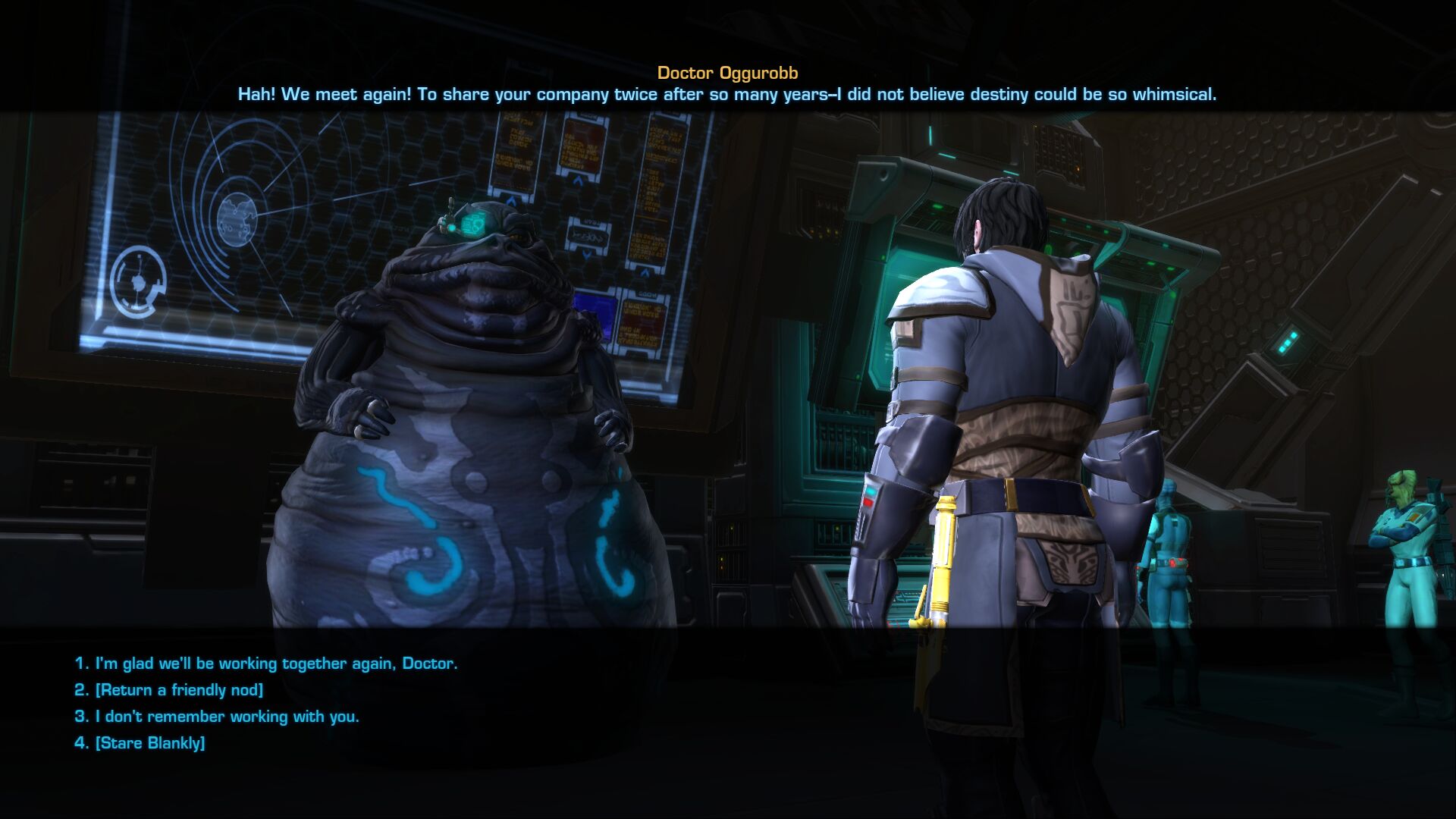
The expansion is a surprise, but the biggest shock is how different the game is as a whole now, from level 1 on up. The experience of creating a new character from scratch and playing through their story right now is…pretty wild. I’ll run down some of the changes from day one to now in key mechanics.
-This big one is in how fast you level up. In the past, you had to do most of the solo quests — whether they were part of your character class’ individual story or just some irrelevant side things — in order to stay on level with the planets you were progressing through. Now, you can stick to the class story quests and a few multi-part faction quests and get through fine. The ones you need are marked in purple, so you’ll know what matters. This huge change allows you to move through the game briskly.
-They have eliminated the need to keep your companion characters geared up. Before 4.0, you had to update your companion characters’ gear the same way you would your own. Their stats are now dictated by character level and your level of “influence” (formerly known as affection) over them. Likewise, any of your companions can fit any of the gameplay roles in the game (damage, tank, healer) instead of having a predetermined one. Both of these changes allows you to proceed through the game alongside the characters you most like, instead of choosing them based on role or just going with whoever has the best gear.
-Specialised class stats (strength, willpower, cunning, aim) have been removed in favour of a single generic one called “mastery,” and most gear in the game has been made adaptive and rather than the restrictive light, medium or heavy designations. In the past the presence of those specialised stats and armour types precluded some characters from being able to use certain gear or mods for said gear. Gear selection is now much less complex than it used to be, and you have greater freedom to wear what you want to wear.
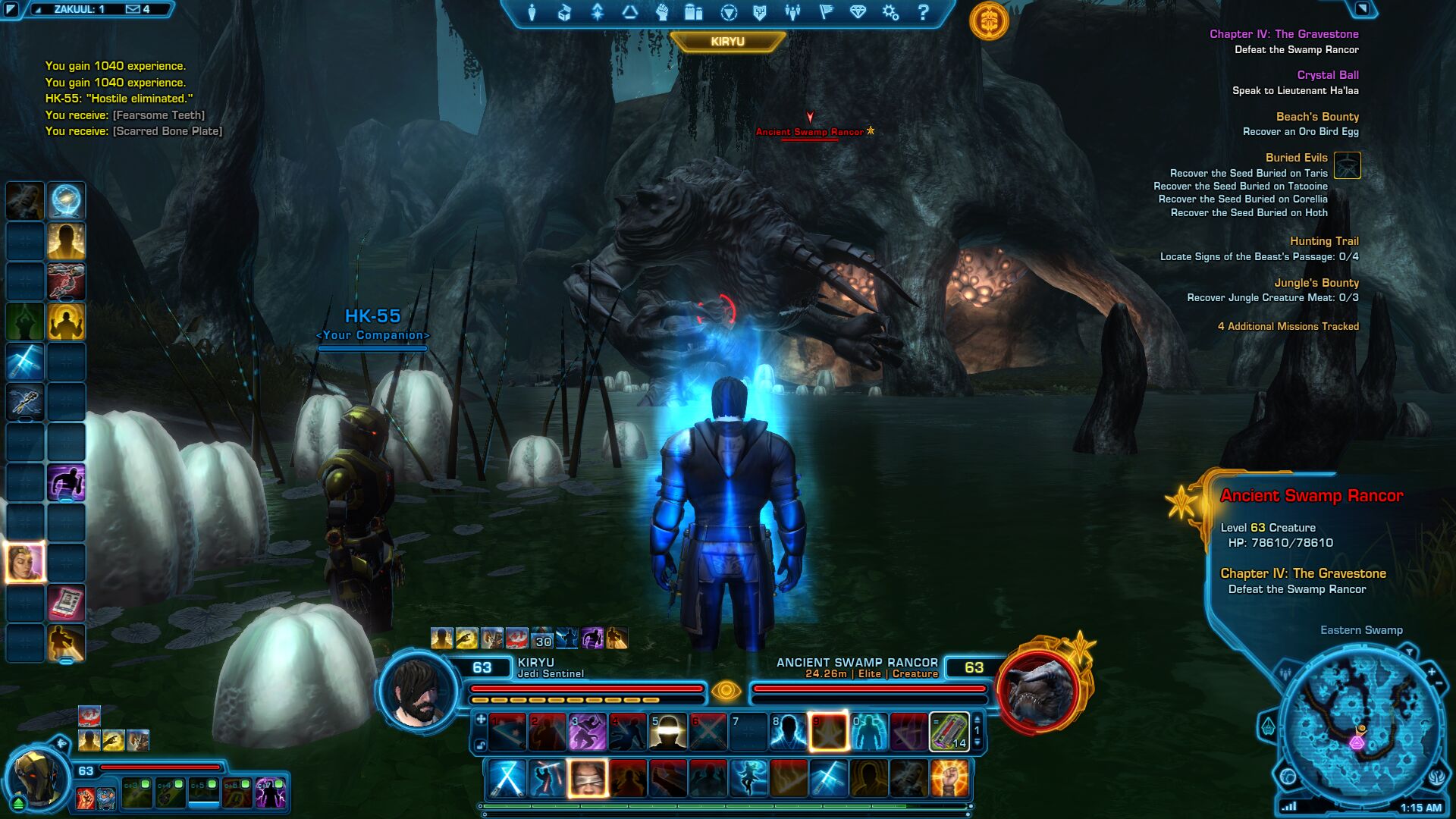
-Navigating the world is less of a hassle, thanks to previous game updates and 4.0. When you go to a planet all the taxi links are unlocked. You can go where you want to go by taxi, rather than having to walk to each one to unlock it. Also, quick-travel bind points (i.e. places you can teleport to from any spot on the map) are unlocked whenever you enter the area they’re in, so you don’t have to remember to click them to unlock them. The level required to be able to use mounts has dropped to 10 for subscribers, as opposed to 25 at launch (!). The sprint ability is granted as soon as you start the game, instead of at level 10 as it was at launch.
-Most group dungeons (flashpoints) now have a solo mode in addition to the old group mode, if you just want to see the story without dealing with people.
That’s hardly a comprehensive look at the way the game has evolved. There are so many things I’m still discovering as I play. I don’t think any of these changes are bad, though the change to companions has resulted in them being overpowered. I expect that will be nerfed at least a bit at some point.
Overall, the changes do feel strange. Having always been somebody who was into SWTOR because I like Star Wars and I like the Bioware-style of storytelling (usually), I’m one of those goobers who over the past four years has built up a roster of 19 different characters, most of which I played at least to level 50. I know all of the planets in the game very well, because I’ve quested through them over and over. Ten of my characters are with the Empire faction, and all of those are at least level 20. That means I’ve gone through the planet Dromund Kaas 10 times. I did that yet again with the 4.0 update, and it honestly made me uneasy.
The game is not constructed to be played as efficiently as is possible now, and since I’m so intimately acquainted with it, I can feel that very clearly. It’s not as if I have any real desire to ever do most of the side quests again, but it’s odd to walk through large areas that were built to contain those quests as I ignore them en route to a main story objective. It’s disconcerting to skip over parts of the game that I know provide significant context for that place in the universe. It’s weird to be tearing through. Maybe new players wouldn’t notice. I definitely do.
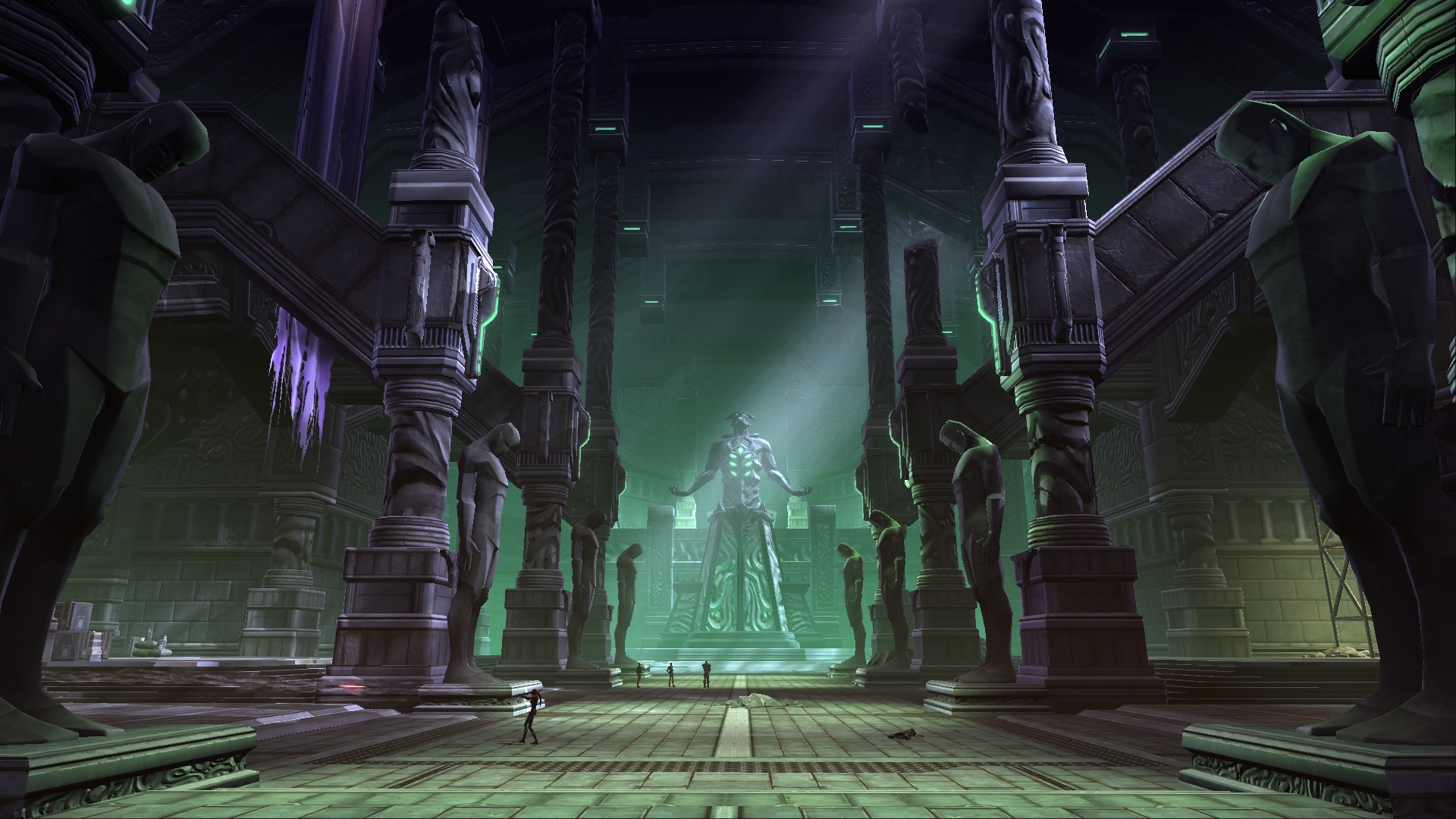
In making something new there is more freedom, so the 4.0 patch shakes up the game and the expansion moves it as far forward as possible. From the moment you start the Knights of the Fallen Empire story it’s a big departure, certainly, but not nearly so much of a shift as would be possible with a standalone sequel. As in life, we all have to live with what Bioware did with SWTOR in the past, even as they try to fix it up as best they can.
“We want to be bold and think outside the box with this expansion, but we also have to be respectful of Star Wars: The Old Republic as it already exists,” Maclean said.
This is another rub, of course. As with any notable game, there are some longtime players who actually liked the way SWTOR was. It’s another minefield they have to navigate in improving the game. And, like it or not, SWTOR is still an MMO and will have to continue to be one. Compartmentalising the story from the MMO stuff is probably the best way to handle this. There aren’t many things they could just flat out remove from the game, but reducing the pain as much as possible helps.
“Life as a developer of an online game is full of regrets,” Maclean said. “We’ll never get better if we don’t look at things we’ve done with a critical eye and say, ‘ You know, that was stupid. Why did we do that?’”
What Bioware has done here is admirable. Developers talk endlessly about being perfectionists and building the best possible experience but that rarely works out. Stories of interference from on high like the one Kotaku published about Destiny last week are a common occurrence, as are tales of money running out and/or hard deadlines preventing games from really being what their creators envisioned. Big budget game development is chaos, and things never quite come out right from that messy process.
I couldn’t tell you exactly why Star Wars: The Old Republic was what it was in 2011, but I do know it was a big fuckup on somebody’s part and that nothing that came after in terms of updates and expansions had been a really impactful course correction until now.
“It’s easy to fall into a pattern and just get used to the way things are and assume that that’s the way they should be,” Boyd said.
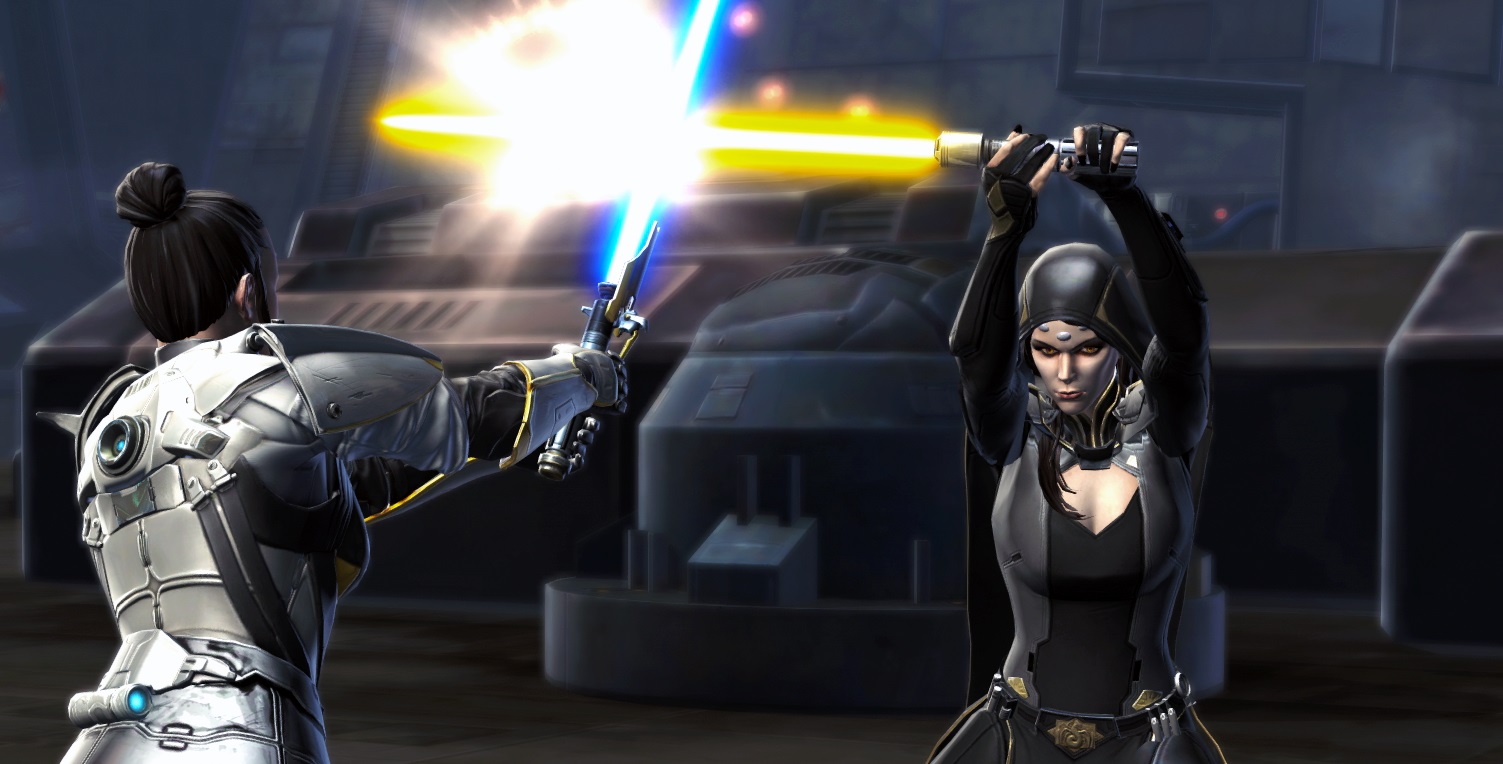
The inertia of doing the same thing over and over is powerful in all facets of life. And acknowledging that human tendency aloud is useful when trying to break free of it. SWTOR is a game that is largely maligned or ignored outside of its community because what most people really wanted from from a Bioware Star Wars game was certainly not a massively multiplayer online game. An MMO is nonetheless what Bioware made, but that clearly doesn’t preclude them from at least attempting to go as hard as they can in the way they’re proven they’re best at, rather than coasting along without much meaningful ambition.
“[Players] want that Bioware role-playing game experience,” Maclean said. “And we can do it. Not only can we do it — we have to do it.”
And they did do it, in what may be the best way they could stuck within the constraints of the game they put out years ago.
“The shape of the story just feels right,” Boyd said. “It feels like this is what we should be doing, and what we should have been doing all along.”
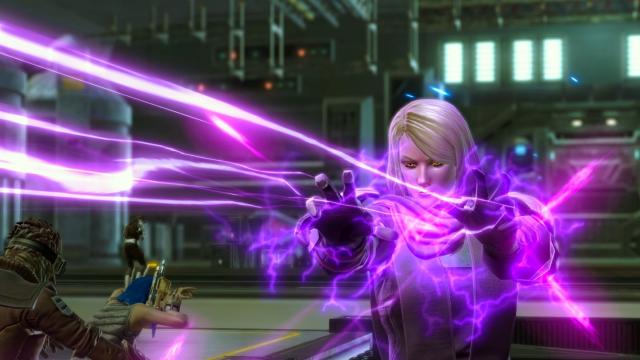
Comments
15 responses to “Star Wars: The Old Republic Now Feels More Like A Classic BioWare RPG”
kotor 3 pls.
4.0 is possibly the closest you will ever get to that right now.
Beniko is back?
I really need to get back into this. I left off at level 58 on the last planet of the Reven expansion. So many other games have drawn my attention at the moment though, so I might hold off until I see the new movie before playing again. That way I can get really Star Warsy for a bit.
A lot of these changes look great and I’m sure I’d love the game if I jumped back in. My problem with MMO’s is that if I’m playing an MMO I won’t have time to play any other video games in the already little amount of time that I have to play them! Solution = Need more gaming time lol
KotFE has been filling my time until FO4 arrives. Have to say, 2 hours into it this morning before work and it is really, really cool. Great environments, camera angles during cutscenes and the dialogue are entertaining.
That MMO whirlpool of doom though. Yeah time flies, that’s for sure.
I started a Level 1 and they have streamlined the MMO part out pretty well.There’s enough quests to give a the planet a story but have culled a ton of fetch and irrelevant quests. Less backtracking across maps etc.
Companions are way OP though. I left for ten minutes came back and my tank companion was taking on 1 gold 1 silver and 2 scrub mobs and he was barely even scratched and was winning.
thats awesome, im currently reinstalling it at the moment
Enjoy!
Yah, the presence scaling for companions at the moment I reckon is fairly overtuned. I’m enjoying it while it lasts though.
My main is a Vanguard tank so it doesn’t put out that much DPS so right now I’ve got the companion doing the DPS… Slow slog.
Good for leveling a DPS character though.
Great! Please release it on console, like Reaper of Souls. Given my recent disappointment in Drage Age Inquisition, I need some good Bioware action to see me through 2016.
Wow. This article has convinced me to pick the old game back up.
The emails I’d seen sent to me by Bioware were all about streamlining the questing, but friends had said that this was primarily a function of experience and marking which ones were ‘critical’. That all the other guff was still there. And I thought back to my levelling experience of constantly updating the wardrobe, hunting for mods to make sure I wasn’t spending two fucking minutes per silver/star trash mob fight, min-maxing my companion gear, crafting, etc, etc, etc…
All the ‘grindy MMO’ey bullshit’ that made the game fail to live up to the KOTOR3 bar that it could’ve. (Seriously, crafting on timers? There’s no reason except padding, and it’s bullshit.)
But not having to give Companions all my hand-me-downs or only use whichever one complements my playstyle meaning I don’t get the really cool dialogue from the ones I’m actually interested in? That’s huge, and I had no idea from the emails.
I’ve really got to pick this up again.
I’m feeling the same way.
If I pick it back up I’ll probably end up doing the side stuff too… just so I’m leveled above the story. But it’ll be great to shed half the shit that that game had dragging it down.
This sounds… very interesting. I played it at launch, got up to lvl 46 I think. Loved the story about being the Sith Emperor’s right hand man, but just gave up in despair after being yet again beat down by some random stupid mob of unarmed prisoners or whatever on some crap fetch quest when I’m supposed to be one of the most dangerous warriors alive. This sounds like they cleared all that crap out which I’m all for.